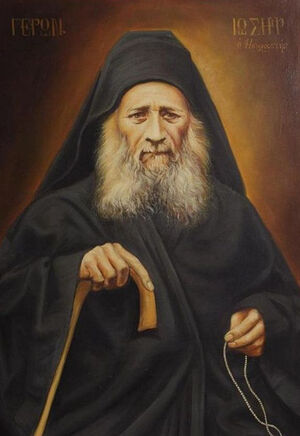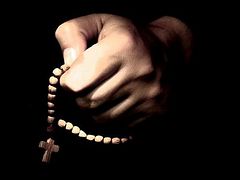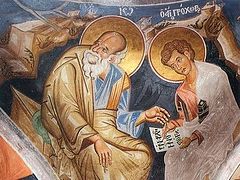On July 23, a small but very spiritually significant church was consecrated in Tbilisi in the name of St. Joseph the Hesychast—a great man of prayer and ascetic of the twentieth century.
At the moment, there is more than one church of St. Joseph, but they were all erected at monasteries, with mainly monastics praying in them. The Tbilisi church is in fact the first parish church in honor of the saint, built first of all for the spiritual needs of the laity. It is to be found at the Church of the Exaltation of the Cross, where the famous Georgian priest and preacher Archpriest Theodore Gignadze serves. It is the third church erected in this church complex. There is a lively liturgical life there. Among the regular parishioners you can see people both young and old, and the former even far outnumber the latter; among the regular parishioners, the men are no fewer than the women. All of this can be explained by the special spirit that reigns in this community, focused on establishing a living, personal relationship with God through the Jesus Prayer and the Eucharist.
The dedication of a church intended for laity to St. Joseph the Hesychast, this famous practitioner of the Jesus Prayer, is itself symbolic. It is no accident that the entrance to this small island of Athonite hesychasm in a modern metropolis is adorned with an inscription calling to prayer: “Lord Jesus Christ, Son of God, have mercy on me.” The holy fathers, including St. Joseph, and many modern spiritual fathers, including the rector of this church, Fr. Theodore, call us in their writings to regularly and even constantly pray, especially this prayer.
Apparently, this dedication is in line with the general orientation of Fr. Theodore and his spiritual children towards the practice of the Jesus Prayer, but, of course, Father can speak about it better himself, so we give the floor to him.
An example of the persistent burning of the spirit
—Fr. Theodore, what distinguishes St. Joseph the Hesychast? What significance does this saint have in the spiritual life of all Orthodox Christians (and not just Greeks)?
—St. Joseph the Hesychast labored at a time when there was a noticeable crisis in the spiritual life. We are referring to the intensity of the Eucharistic life and hesychastic practice—not only in the monastic, but also in the lay environment. If we look at the holy ascetics of the twentieth century, whether on Mt. Athos or in Greece, we see a kind of upsurge in the spiritual life—at least we see it from our position. We see a multitude, a galaxy of saints whose canonizations are still ongoing in the Greek world. Many of them are worthy of the closest attention. In particular, there is one of my most beloved saints—St. Silouan the Athonite. Then came the canonization of his spiritual child, Archimandrite Sophrony (Sakharov). And there’s St. Paisios, and many others.
Many of them are outstanding ascetics, but still, St. Joseph stands out among them by his productivity, if I can express it that way. I often say that he is the most productive saint of the twentieth century from the point of view of his fruits. And by his fruits, I mean a quantitative indicator too. Today there are many centers of the spiritual life that are continuations of his school. There are representatives of his school not only in Greece, but beyond its borders as well: on Mt. Athos, on Cyprus, and even in America. The following monasteries were founded by the brotherhood of St. Joseph and the students of his spiritual school: on Mt. Athos—six monasteries, the Skete of St. Anna, and many other separate cells; in the rest of Greece—eighteen monasteries; on Cyprus—six; in America—sixteen; in Canada—two, and in Italy—one. There are about 1,000 monastics laboring in these monasteries, and their number continues to grow. Additionally, there are parish churches that are the successors to the school of St. Joseph in the world. We believe this number will continue to grow.
Another thing I should mention, that we heard ourselves in the Greek world, including on Cyprus: St. Joseph the Hesychast is called the modern St. Gregory Palamas, because he revived hesychasm, including among the laity, and the modern St. Nikodemos the Hagiorite, because he, like St. Nikodemos, contributed to the revival of the Eucharistic life—I mean the intense Eucharistic life. After all, it was St. Nikodemos who called for frequent Communion in the eighteenth century.
St. Joseph also had an interesting personal trait, which, of course, is characteristic of every saint, but in reading his life, it’s especially evident and highlighted, and Metropolitan Athanasios of Limassol especially emphasizes it: That burning of spirit with which St. Joseph entered the Holy Mountain and which he preserved until the end of his earthly life. That is, the elder was a staunch warrior who never backed down.
And what do we, modern Christians, every Orthodox today, need most of all? An intense Eucharistic life, and the revitalization of the hesychastic practice in our soul, whatever status we have in the Church, even if we’re laymen. There is no Christianity without a burning spirit—the apostle Paul calls us to this (cf. Rm. 12:11). St. Joseph the Hesychast is a striking example for us of the persistent burning of the spirit.
—What episodes from his life are especially worthy of emulation on the part of modern Christians?
—For example, his attitude towards fulfilling the typikon is very interesting. We know what kind of typikon this small brotherhood led by St. Joseph the Hesychast had. They kept a nighttime vigil—meaning the noetic Jesus Prayer. In fact, the core of their lives was at night. They labored by day so as to engage in an intense search for God by night. And they did everything for this purpose, in no way violating this typikon.
It is well known that they had material difficulties, because they were not within the walls of a large monastery. They were offered fish, but to take care of it meant canceling their night prayer, or at least part of it—that is, it required violating their typikon. If they prepared for their nighttime service as they were supposed to, as called for by their typikon, then the fish would go bad. And we know from the life of St. Joseph that the fish still spoiled, and the nighttime service was held in the usual way. This is a fundamental approach to rising for prayer at night.
It’s a tradition of all saints, especially the Athonite fathers, to pray at night. But St. Joseph showed this especially emphatically. This is also the case in our small practice, the practice of our community: Since its members, laymen, including those with families, love this saint, they also love to get up at night for prayer. And if they don’t have some job that makes it absolutely impossible, many of them manage to do it—to pray with noetic prayer at night. And they accumulate a personal and very interesting experience of the spiritual life.
A church disposed towards hesychastic prayer
 —Do a lot of people know this saint in Georgia? Why did you decide to build a church of St. Joseph in Tbilisi? Is it connected with the practice of the Jesus Prayer that St. Joseph calls us to?
—Do a lot of people know this saint in Georgia? Why did you decide to build a church of St. Joseph in Tbilisi? Is it connected with the practice of the Jesus Prayer that St. Joseph calls us to?
—I wouldn’t say that many people know Fr. Joseph, although they’ve recently more or less begun to get acquainted with this saint. The book of Fr. Ephraim, one of his spiritual children, was translated into Georgian. The instructions to monks of Fr. Joseph himself were already translated long ago, although they have not been particularly popular yet. People weren’t familiar with them, and only a small part of them were translated. But he is becoming known to many now.
We, our community, consider it a special grace of God that we erected this church; we consider it a special grace that we have a connection with this saint and with his spiritual school. The building of the church was a direct sign from God for us, although it wasn’t particularly easy, accompanied by certain difficulties. But thank God, the church was built.
It turned out to be very precise, beautiful, and similar to the ancient churches that were built in Georgia in the sixth century, according to ancient tradition, completely made of stone, with very beautiful, in our view [smiles], icons and mosaics inside. The church is small, but very precise; it corresponds to Fr. Joseph and his small brotherhood. It resembles a small cave, if I may say so, and it disposes those who come in to hesychastic prayer.
And, of course, the idea of building such a church is precisely in popularizing this saint, and, accordingly, in popularizing hesychastic noetic prayer and the intense Eucharistic life, without which, we believe, Christianity is impossible. Because Christianity is Christ, and Christ dwells in our hearts, as He established, through the Eucharistic life (cf. Jn. 6:56). And noetic prayer is a searching step we make towards Him. We must always look for Him, try to be with Him.
The erection of this church aims to highlight this way of life. I repeat again: Fr. Joseph, now St. Joseph, called laity to this prayer too. So I think this church will attune many to learn noetic prayer, which is something we have to learn.
Our teachers and their lessons
 Elder Ephraim of Arizona —Do you personally know the disciples of St. Joseph—Fr. Ephraim of Arizona and others—or disciples of his disciples? If so, please tell us about them.
Elder Ephraim of Arizona —Do you personally know the disciples of St. Joseph—Fr. Ephraim of Arizona and others—or disciples of his disciples? If so, please tell us about them.
—We had the good fortune of getting acquainted with a spiritual child of Fr. Joseph—Fr. Ephraim of Philotheou and Arizona. There is a popular documentary film about him, many write about him, and his books have also been published both in Georgian and Russian. In general, as the Lord teaches us: The tree is known by its fruit (Mt. 12:33, Lk. 6:44)—and look at Fr. Joseph’s fruit!
It’s very difficult to establish monasteries of the type that Fr. Ephraim created in America. His missionary work was very non-standard: He didn’t know English; as a rule, he was less of a missionary verbally—his main missionary tool was internal prayer.
And the fact is evident. The monasteries he founded are simply amazing, especially the monastery he founded in Arizona. The monks there are filled with joy, constantly praying and receiving Communion. The missionary work of these monasteries, like the missionary work of Fr. Ephraim, flows from their way of life.
Fr. Ephraim and his brethren in America were truly a candle lit on a table and a city built on a hill and a true example of how missionary work should be done. And this is nothing new: The Lord teaches us to be a light of this world, and our light should so shine so that when others see it, they would also begin to seek God (cf. Mt. 5:14-16). The candle that burns in our hearts from Christian faith must, as the apostle Peter says, turn into the sun, into the dawn (cf. 2 Pt. 1:19). And Fr. Ephraim was a man in whose heart this candle that burns in the heart of every Christian turned into the sun. And it did so by the practice, the faithful following of the school founded by Fr. Joseph. We read how this happened in his life. For example, Fr. Ephraim says: “The purpose of our life, its meaning was in the Jesus Prayer; we breathed by it.” They lived by it, and that was that! Additionally, they had an intense Eucharistic life—and the result is obvious.
What else can I say? Those who have read the book of Fr. Ephraim, My Elder Joseph the Hesychast, probably remember what a sense of humor he had. And he kept this humor until the end of his life. When I met him, you could still feel it. Although the elder was already quite infirm, he had this simple humor, generated by happiness—happiness that he constantly bore within himself.
At the same time, I felt some kind of strength in him: Whenever he passed by somewhere, you’d suddenly want to press up against the wall. He had a small body, you could say that he was fragile, like a sparrow, but he possessed great inner strength. Okay, someone could say it was a purely psychological thing, based on his authority, but still, everyone noticed that he was endowed with some amazing internal strength.
 The Monastery of St. Anthony the Great in the Arizona desert
The Monastery of St. Anthony the Great in the Arizona desert
You know, even if it were something psychological here, you still couldn’t escape the facts. A man goes to America, and in a short period of time, he founds eighteen whole monasteries! What must it have been like to establish just one such monastery, especially in a country where Orthodoxy is far from being the main religion? Even in Greece, I can say that it’s difficult enough to do—to establish a monastery of this type. Therefore, you can’t consider the feeling of this power in Elder Ephraim to be a purely subjective moment—it was a reflection of objective reality. That’s our view of the matter.
As for other disciples, glory to God, we communicate with Fr. Paisios (Papagianou), the abbot of the monastery in Arizona; and with Fr. Ephraim, the abbot of Vatopedi, who has taught us a lot; also with Vladyka Athanasios, the Metropolitan of Limassol, from whom we learn a lot of things.
What can I say about them? I emphasize: I would like to talk about the Liturgy celebrated by them and the priests trained by them. We know, we’ve all read, how St. John of Kronstadt served the Liturgy. No one served like he did, as his contemporaries said. Unfortunately, today we can’t see and hear how this great saint served, one of my most beloved saints. But still, the conclusion is that a service can be celebrated more majestically or less majestically.
The special thing that characterizes this school is how the services are celebrated. How is this manifested? Not in the form, of course, but in something internal, in some nuances that are difficult to convey in words. It is extreme reverence before the altar; it is extreme freedom combined with reverence, but not in forms, of course. I mean inner freedom.
The have a striking intonation of voice, which is not artificial, but absolutely natural, coming from the heart, and it points to the hesychastic state of the one serving, to the existence of their hesychastic practice. Ideally, the Liturgy should be the crown of hesychastic practice.
If someone has no experience of going deep within himself, of seeking God within himself, then the Liturgy he celebrates will naturally bear a more external character, and it will be less helpful for the people who are called to participate in the Eucharistic service. This is exactly what I meant in the services of those whom I listed, and in the services of their pupils: services celebrated with an internal hesychastic spiritual attitude. That’s how I see it.
We have learned a lot from them. Once again, this teaching is not simply verbal—something to write down, something they tell you. You have to touch it; it is transmitted through touch. I told you about Fr. Ephraim, that he had a striking inner strength, and you could feel it. Communicating with such people again confirms the truth that the principle of succession in the spiritual life—from mentor to spiritual child—is incredibly important. Because there are a lot of things that simply can’t be deduced from a book. No matter how it’s written, you can’t pick it up. Many things are perceived simply by touch: You have to go, see, touch, and experience. Therefore, I always advise those who ask, especially those who want to serve in monasticism or in holy orders in the future, who are studying in theological educational institutions, that they must have a certain connection with representatives of this school. It’s very important.
Hesychasm is the Orthodox way of life
 —What from the spiritual inheritance or instructions of St. Joseph is most important for modern Christians?
—What from the spiritual inheritance or instructions of St. Joseph is most important for modern Christians?
—From the spiritual heritage of Fr. Joseph, as I have already said, the ability to fight, the fact that he didn’t like to retreat, loyalty to his principles, which are axiomatic for the life of a Christian, without which Christianity does not exist, are deserving of special attention. It’s the Eucharistic life. In particular, he received from St. Daniel the Hesychast that it is desirable to serve the Liturgy of the Presanctified Gifts every weekday in Great Lent. And we, glory to God, have adopted this practice: We serve this Liturgy every day in Lent in our church, not just on Wednesdays and Fridays. And this has turned out to be very important for our parishioners: Practice shows that the more often someone communes, the more he develops spiritually.
Don’t go backwards in the spiritual life! If you decide to start the Jesus Prayer, you have to choose some time out of the twenty-four hours. It’s acrobatics—get up at night to pray; if that doesn’t work out—at dawn, or in the evening, or in the afternoon—only, it has to be done with the nuances that St. Joseph taught us—sitting in the dark, and so on. It’s very important. Of course, you need a mentor and guidance for this, but such guides exist, thank God. And don’t step back, don’t toss it aside. It’s better to do a little every day than to do a lot just once a week. Consistency is very important.
And, of course, the amazing humility of Fr. Joseph, his vision of his own unworthiness. St. Joseph says of himself that he achieved nothing and brought forth no fruit at all. And seeing this, he tried every day to lay a beginning to the spiritual life, because he absolutely did not like his preceding life and he considered that he had done nothing and had not even begun to repent, as he should. “Every day I am put to shame again, because even though I want to, I couldn’t start again”—such amazing humility, without which there can be no sanctity! So, may St. Joseph help us, a truly great ascetic, the most productive saint, as I call him. Thank God, his spiritual school is alive.
And of course, he is in absolute unison with the saints that I listed at the beginning: Sts. Silouan the Athonite, Sophrony (Sakharov), and other saints and ascetics who have already been canonized or whose canonization is yet to come only because there were many such ascetics in the Greek world in the twentieth century. And it’s also important for us that these people weren’t lost somewhere in history, but are here right now, and their disciples are our contemporaries. So the spiritual life is just as possible today as it was in the first centuries of Christianity and in the middle ages. May St. Joseph help us and intercede for us before God, that we might be able to live the true spiritual life.
I would like to say something else: When people hear the word “hesychasm,” they think it’s a certain way of life and necessarily monastic—the eremitic life. Or, another mistake is that they understand hesychasm to mean some high spiritual state. Yes, of course, it can be defined this way, but in reality, it is a way of life that is properly Orthodox. Why do other denominations not have this practice? It comes from the theology of the Orthodox Church—this is very important to remember. We have the teaching about the Uncreated energies that was dogmatically established at Church councils under St. Gregory Palamas. Under him, the faithfulness of the eternal practice of the Jesus Prayer was also confirmed. This is very important. This is a unique phenomenon in the Christian world and one of the manifestations of the uniqueness of Orthodoxy.
Therefore, by denying it, we might nominally remain in the bosom of the Orthodox Church, but we won’t have access to its primary precious vein. It is important to see it and understand it this way. For those of us who live in the world, hesychasm is not the highest state where a man gives himself up to contemplation and already has this gift, but it is a way of searching for God within ourselves, of retreating into our hearts in order to meet Christ.
The essence of the Christian life and everything that happens in Christianity is directed towards one goal—to meet Jesus Christ, to get to know Him personally, so that at the Judgment he would not say about me: “I don’t know you, Theodore”—we know there are examples of this in the Gospel (cf. Mt. 7:21-23, 25:1-12); and that He would know me personally. Personal relationships have the principle of synergy. I should also look for Him and try to get to know Him. This is what hesychasm is. The goal: I know that God came as man, and I want to know Him. Where should I search for Him? I know where: I believe that He is God, and He told me that He stands at my heart, in the depths of my heart, knocking gently. Perhaps someone will hear (cf. Rev. 3:20). How could I, being a Christian, not look for Him?! As soon as I decide to seek for Him, I will ask: Where?—of course, within myself, in my heart, as the Lord taught us; then I begin to learn that there is already a 2,000-year practice of seeking Him—and this is exactly what hesychasm is.
May the Lord Jesus Christ help us in this, our most important work! Amen.




